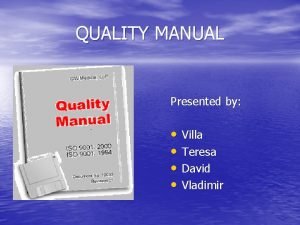Cultural ecosystem services of seminatural greenspace A case

- Slides: 1

Cultural ecosystem services of semi-natural greenspace. A case study of conservation grazing. Damian J Smith 1, Paul Oldfield 2, Philip James 1 Introduction Results (continued) • Social-ecological systems provide a conduit through which the traditionally • Thematic analysis of comments revealed three ecosystem services delivered by separated sciences of ecology and sociology interact. Ecosystem services, those the greenspace: Natural history interest, a sense of ownership, and a sense of benefits provided by nature to human society, are integrated within social- history (Figure 3). ecological systems as feedback flows. • Managing the environment for ecosystem services has gained prominence in recent years, most notably since the publication in the United Kingdom of the UK National Ecosystem Assessment which presented known information on extant Table 1: Summary of total visitor activity over 75 hours for the 2011 grazing period. Showing active interest by category. Category Total % total visitors active interest % active interest bird watcher 10 0. 5 10 100 dog walker 111 5. 9 45 40. 5 • Cultural ecosystem services are those intrinsic benefits derived from spending walker 334 17. 7 132 39. 5 time in nature. Empirical data relating to cultural ecosystem services in semi- fisher 102 5. 4 13 12. 7 natural urban greenspace management have been shown to be one of the least cyclist 1256 66. 5 113 9. 1 explored elements of nature’s benefits. runner 42 2. 2 2 4. 8 motorbike 35 1. 9 0 0 Total 1890 ecosystem services within the UK (UK-NEA, 2011). • Conservation grazing of saltmarsh has been shown to increase diversity of plants and create suitable breeding habitat for waders in particular (Doody, 2008). 317 Managing greenspace to enhance and improve biodiversity has health and wellbeing benefits to people using these spaces. • As part of a wider effort to maximise ecosystem services delivered by the Upper Mersey Estuary through conservation grazing, the aim of the current study is to examine and elicit the effects of conservation management on cultural ecosystem services, using ethnographic methods. Figure 2: Tag cloud showing the prominence of words taken from comments during the grazing period, n= 62. 1. Natural history interest “I’ve seen a lot more lapwing this year” “We need more wildlife. ” “It’s well down that grass. “ “It’s about time we had some nature. ” 2. A sense of ownership “I always check on them when I come down. ” “I’ve come to check on my ladies. ” “We couldn't see them for a while, we thought they were swimming. “ Figure 1: An English Longhorn cattle with Fiddler’s Ferry power station in back ground. Methods • Six English Longhorn cattle (Figure 1) were introduced to a 5 ha area at Widnes Warth, an unmanaged urban centred salt marsh in Cheshire, during the summer of 2011, to graze for conservation. • Visitors were unobtrusively observed and behaviour relating to active interest (or 3. A sense of history “I remember the old days when this was a mess. . . ” “When I was a lad. . . ” “It was awful back in the day. . . ” “It’s cleaned up fantastic. . . it used to be disgusting. . . ” not) was recorded. • Informal interviews were carried out with visitors who took an active interest in the Figure 3: Thematic analysis of comments, strong evidence for three ecosystem research and comments transcribed following these interactions. goods emanating from cultural ecosystem services was revealed. • A tag cloud was created using Wordle™ software to illustrate those words Discussion dominating the comments. • Further to this, a thematic analysis was carried out on the comments to illuminate and elicit those ecosystem services related to well-being within the cultural service enclave. Results • 1890 individuals were observed during 75 hours of survey. Cyclists comprised the majority (1256) followed by walkers (334) and dogwalkers (111). Bird watchers showed the highest active interest by percentage (100% , n = 10) followed by dog walkers (40. 54%, n = 111) and walkers (39. 5%, n = 334). See Table 1. • The tag cloud showed initial stages of themes coming from comments made by visitors. Amongst others: “used to” refers of a sense of history, ‘wildlife’ to natural history interest, and ‘check on’ to a sense of ownership (Figure 2). and Environment Research Centre, School of Environment and Life Sciences, The University of Salford, Greater Manchester, M 5 4 WT 2 Mersey Gateway Project, 3 rd Floor, The Waterloo Centre, Widnes, WA 8 0 PR Research is funded by Halton Borough Council. • The enhancement of cultural ecosystem services provided by an urban greenspace are illustrated in the results. The cattle provided a focus for recreational users over various categories. It is unsurprising that bird watchers was the category with the highest percentage of interest in the grazing site. However, there were relatively few bird watchers visiting the site – management could increase the amenity attraction to the conservation grazing site through bird hides for example. • The tag cloud and thematic analysis provides clear evidence of the positive emotions and attributes of well-being associate with the cattle grazing. The more prominent words and themes extracted from the comments imply cultural ecosystem services are being delivered through the recreational experience. • Empirical evidence has been provided to show a conservation grazing project has enhanced cultural ecosystem services. 1 Ecosystems References: Doody, , J. P. (2008). Saltmarsh Conservation, Management and Restoration (Vol 12). Netherlands: Springer UK-NEA (2011) The UK National Ecosystem Assessment: Chapter 1. Introduction. Cambridge: UNEP -WCMC

